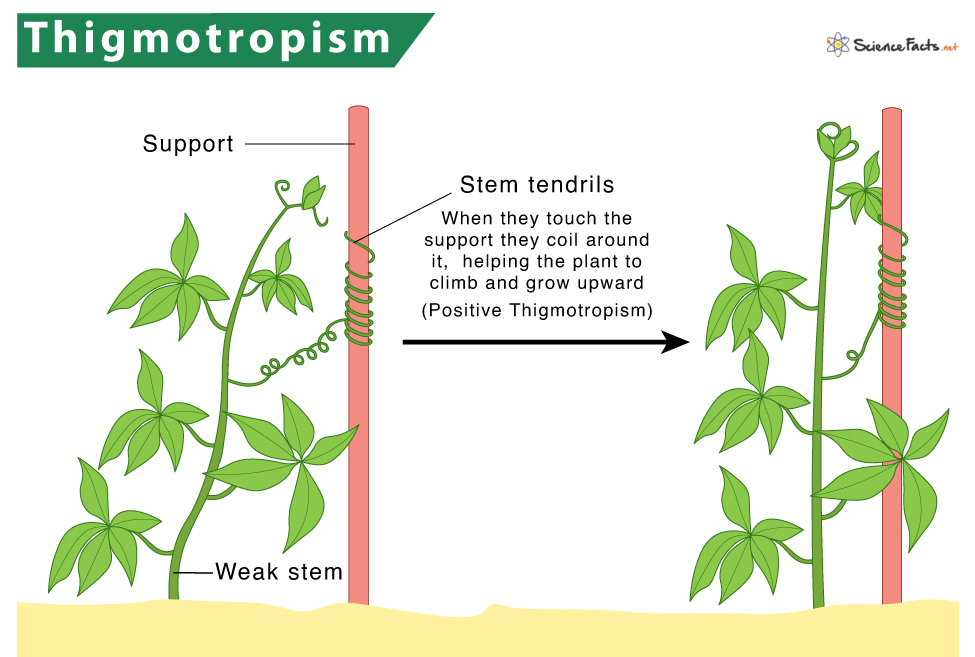Thigmotropism
What is Thigmotropism
Thigmotropism, also known as haptotropism or stereotropism, is a kind of tropic movement in which plant parts grow or move in response to touch or contact with a solid object. In simple terms, a plant alters its regular pattern or direction of growth due to an external touch stimulus. Though it mainly occurs in twining plants and tendrils, it can also be found in flowering plants and fungi.
This tropic movement has got its name from the Greek word ‘thigmo’, meaning ‘touch’.
Its Types
Like any other tropism, it is also classified into two types based on whether the plant grows towards the stimulus of touch or away from it.
1. Positive Thigmotropism
When a plant grows towards the stimulus of touch, it exhibits positive thigmotropism.
Examples
Tendril coiling: It is primarily observed in climbing plants or vines with specialized tendrils. Tendrils are specialized leaves, stems, or petioles, having a thread-like appearance. They grow in a revolving pattern, where the tip bends in various directions forming spirals and irregular circles in search of support. When the tendril touches an object, sensory epidermal cells on its surface get stimulated. As a result, the tendril coils around the support, thus helping the plant to climb. This activity also provides better light exposure for photosynthesis and also increases the visibility of their flowers to pollinators. This type of growth, where one side of the plant is signaled to grow faster than the rest of the plant upon stimulation is referred to as differential growth.
2. Negative Thigmotropism
When a plant grows away from the stimuli, it displays negative thigmotropism.
Examples
Movement in roots: Roots exhibit negative thigmotropism. When they come in contact with an object, they often change their direction in response to the contact stimulus and grow away from it. Avoiding objects allows roots to grow unhampered through the soil and increases their chances of obtaining nutrients.
How Does It Work in Plants
The sensitivity of touch stimulus varies in different plant types. For instance, a tendril of the Sicyos plant can detect a weight of 0.00025mg, whereas a sundew plant can detect a weight of 0.0008mg. Auxin is the critical regulator of the process.
The mechanism of thigmotropism is as follows:
1. At first, when a plant part, specifically the leaf or stem tendrils, touches a solid object, the cells present in that region begin to produce auxin.
2. This auxin then gets transferred to the adjacent untouched cells. Being a growth hormone, auxin promotes cell elongation. As a result, the untouched cells grow faster, causing them to bend around the stimulus.
3. The signal arises from the outermost layer of the plant surface, the epidermis, where densely populated with tiny hair-like structures called tactile papillae are present. The layer has well-established intercellular connections, called plasmodesmata.
4. When a touch stimulus comes in contact with these hairs, the cell membrane of that part is temporarily broken down; this causes the cell to change its turgidity or shape, resulting in a curved or coiling movement.
5. The phytohormone ethylene helps change the shape or turgidity of the cell. The response is immediately transferred to the adjacent cells towards the untouched part of the plant through plasmodesmata. This reaction occurs very fast.
6. This whole mechanism of transfer of auxin from the touched to the untouched site is slightly complicated. According to some research, this mechanism may vary from species to species.
FAQs
Ans. The difference between phototropism, geotropism, hydrotropism, and thigmotropism in plants are in their respective stimuli, which are light, gravity, water, and touch, respectively.
-
References
Article was last reviewed on Monday, March 14, 2022




